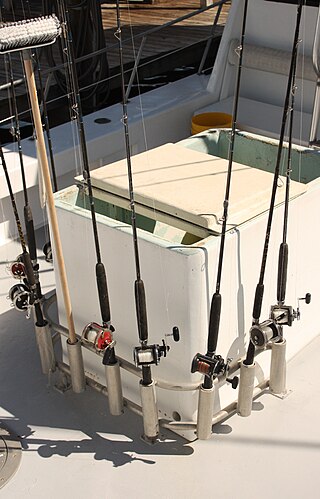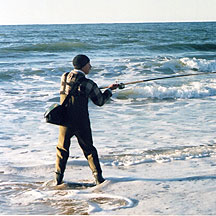Related Research Articles

Fishing is the activity of trying to catch fish. Fish are often caught as wildlife from the natural environment, but may also be caught from stocked bodies of water such as ponds, canals, park wetlands and reservoirs. Fishing techniques include hand-gathering, spearing, netting, angling, shooting and trapping, as well as more destructive and often illegal techniques such as electrocution, blasting and poisoning.

Trolling is a method of fishing where one or more fishing lines, baited with lures or bait fish, are drawn through the water at a consistent, low speed. This may be behind a moving boat, or by slowly winding the line in when fishing from a static position, or even sweeping the line from side-to-side, e.g. when fishing from a jetty. Trolling is used to catch pelagic fish such as salmon, mackerel and kingfish.

A fishing rod is a long, thin rod used by anglers to catch fish by manipulating a line ending in a hook. At its most basic form, a fishing rod is a straight rigid stick/pole with a line attached to one end ; however, modern rods are usually elastic and generally have the line stored in a reel mounted at the rod handle, which is hand-cranked and controls the line retrieval, as well as numerous line-restricting rings that distribute bending stress along the rod and help dampening down/prevent line whipping and entanglement. To better entice fish, baits or lures are dressed onto the one or more hooks attached to the line, and a bite indicator is used, some of which might be incorporated as part of the rod itself.

A fishing reel is a hand-cranked reel used in angling to wind and stow fishing line, typically mounted onto a fishing rod, but may also be used on compound bows or crossbows to retrieve tethered arrows when bowfishing.

A fishing line is any flexible, high-tensile cord used in angling to tether and pull in fish, in conjunction with at least one hook. Fishing lines are usually pulled by and stored in a reel, but can also be retrieved by hand, with a fixed attachment to the end of a rod, or via a motorized trolling outrigger.

Bass fishing is the recreational fishing activity, typically via rod-based angling, for various game fishes of North America known collectively as black bass. There are numerous black bass species targeted in North America, including largemouth bass, smallmouth bass, spotted bass or Kentucky bass, and Guadalupe bass. All black bass species are members of the sunfish family Centrarchidae.

Fly fishing is an angling technique that uses an ultra-lightweight lure called an artificial fly, which typically mimics small invertebrates such as flying and aquatic insects to attract and catch fish. Because the mass of the fly lure is insufficient to overcome air resistance, it cannot be launched far using conventional gears and techniques, so specialized tackles are used instead and the casting techniques are significantly different from other forms of angling. It is also very common for the angler to wear waders, carry a hand net, and stand in the water when fishing.

Angling is a fishing technique that uses a fish hook attached to a fishing line to tether individual fish in the mouth. The fishing line is usually manipulated via a fishing rod, although rodless techniques such as handlining also exist. Modern angling rods are usually fitted with a fishing reel that functions as a cranking device for storing, retrieving and releasing out the line, although Tenkara fishing and traditional cane pole fishing are two rod-angling methods that do not use any reel. The fish hook itself can be additionally weighted with a denser tackle called a sinker, and is typically dressed with an appetizing bait to attract and entice the fish into swallowing the hook, but sometimes an inedible fake/imitation bait with multiple attached hooks is used instead of a single hook with edible bait. Some type of bite indicator, such as a float, a bell or a quiver tip, is often used to relay underwater status of the hook to the surface and alert the angler of a fish's presence.

Big-game fishing, also known as offshore sportfishing, offshore gamefishing or blue-water fishing, is a form of recreational fishing targeting large game fish, usually on a large body of water such as a sea or ocean.

Recreational fishing, also called sport fishing or game fishing, is fishing for leisure, exercise or competition. It can be contrasted with commercial fishing, which is professional fishing for profit; or subsistence fishing, which is fishing for survival and livelihood.

A fishing lure is any one of a broad category of artificial angling baits that are inedible replicas designed to mimic prey animals that attract the attention of predatory fish, typically via appearances, flashy colors, bright reflections, movements, vibrations and/or loud noises which appeal to the fish's predation instinct and entice it into gulping the lure. Angling activities using lures are known as lure fishing.

In angling, casting is the act of the angler throwing the bait and hook as well as other attached terminal tackles out over the water, typically by slinging a fishing line manipulated by a long, elastic fishing rod. The term itself may also be used for setting out a net when artisanal fishing.

Rock fishing is fishing from rocky outcrops into the sea. It is a popular pastime in Australia and New Zealand. It can be dangerous and many people have died. This may improve as more people who are rock fishing are beginning to wear life jackets.
Heddon is a brand of artificial fishing lures created by James Heddon, who is credited with the invention of the first artificial fishing lures made of wood in the late 1890s.

Fishing tackle is the equipment used by anglers when fishing. Almost any equipment or gear used in fishing can be called fishing tackle, examples being hooks, lines, baits/lures, rods, reels, floats, sinkers/feeders, nets, spears, gaffs and traps, as well as wires, snaps, beads, spoons, blades, spinners, clevises and tools that make it easy to tie knots.

Coarse fishing is a phrase commonly used in Britain and Ireland. It refers to the angling for rough fish, which are fish species considered undesirable as food or game fish. Freshwater game fish are all salmonids, particularly salmon, trout and char. Generally, coarse fish are freshwater fish that are not salmonids, though there is often disagreement over whether grayling should be classified as a game fish or a coarse fish.

Surf fishing is land-based game fishing while standing on the shoreline or wading into the surf zone. A general term, surf fishing may or may not include casting a lure or bait, and refers to all types of shore fishing – from sandy and rocky beaches, rock jetties, or even fishing piers. The terms surfcasting or beachcasting refer more specifically to surf fishing from the beach by casting into the surf at or near the shoreline. With few exceptions, surf fishing is done in saltwater. The most common misconception about surf fishing is the idea that one must cast as far out as possible in order to reach the fish. At beaches on the west coast of the United States, and in fact, at most beaches around the world, you only really need to get your bait into knee-deep water. This is referred to as surf fishing the "skinny".

Fishing techniques are methods for catching fish. The term may also be applied to methods for catching other aquatic animals such as molluscs and edible marine invertebrates.

Fishing bait is any luring substance used specifically to attract and catch fish, typically when angling with a hook and line. There are generally two types of baits used in angling: hookbaits, which are directly mounted onto fish hooks and are what the term "fishing bait" typically refers to; and groundbaits, which are scattered separately into the water as an "appetizer" to attract the fish nearer to the hook. Despite the bait's sole importance is to provoke a feeding response out of the target fish, the way how fish react to different baits is quite poorly understood.
Hardy Fishing Rods is a brand of Pure Fishing.
References
- ↑ "History of E. A. Pflueger Antique Lures". www.oldfishinglure.com. Retrieved 2018-04-04.
- ↑ Artificial fish-bait, 1883-02-13, retrieved 2018-04-04
- ↑ "History Of Pflueger Fishing Lures | Vintage Collectible Pflueger Bait -". fishinglurecollectibles.net. Retrieved 2018-04-04.
- ↑ "Pflueger Lures - Fin and Flame Fishing For History". finandflame.com. Retrieved 2018-04-04.
- ↑ Miller, Robert (2009). The History of the Pflueger Akron & Summit Casting Reels. Cincinnati, OH: Whitefish Press. ISBN 978-0984205066.